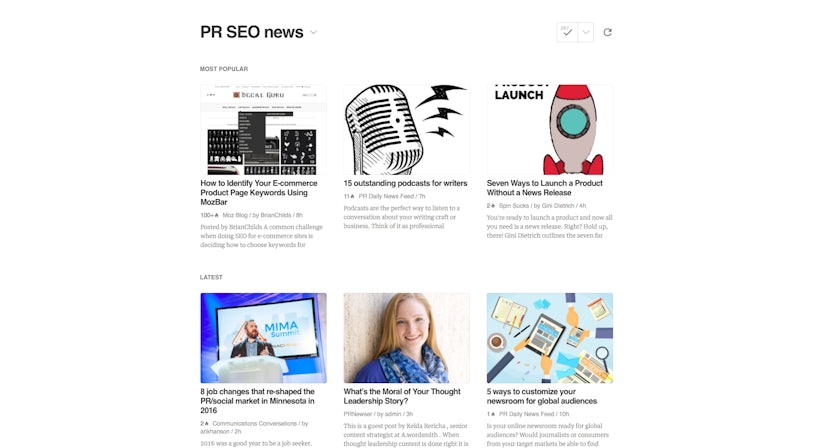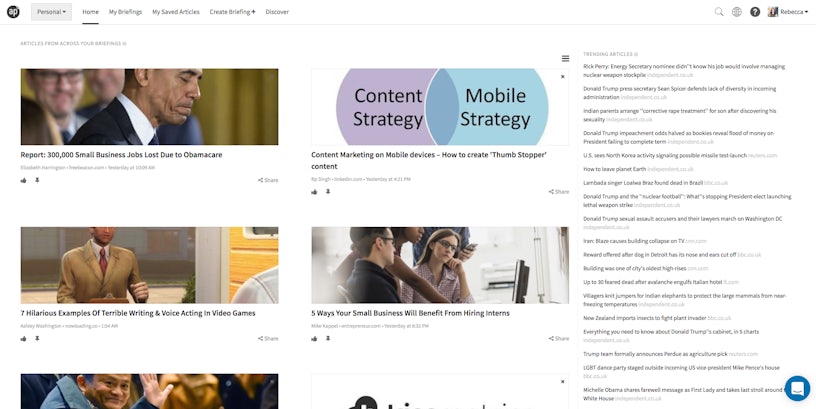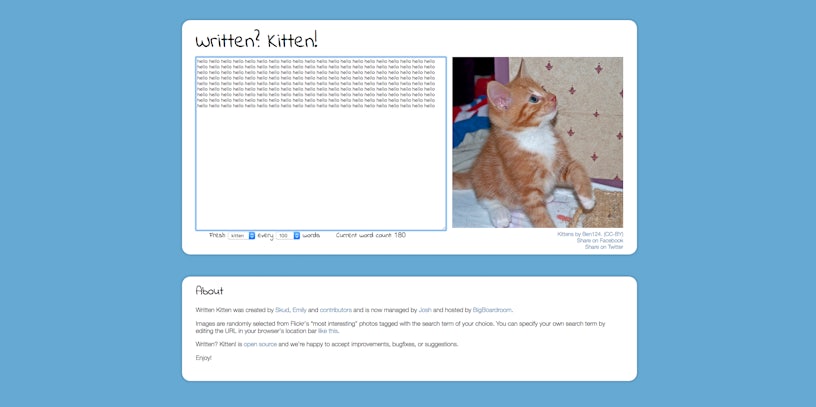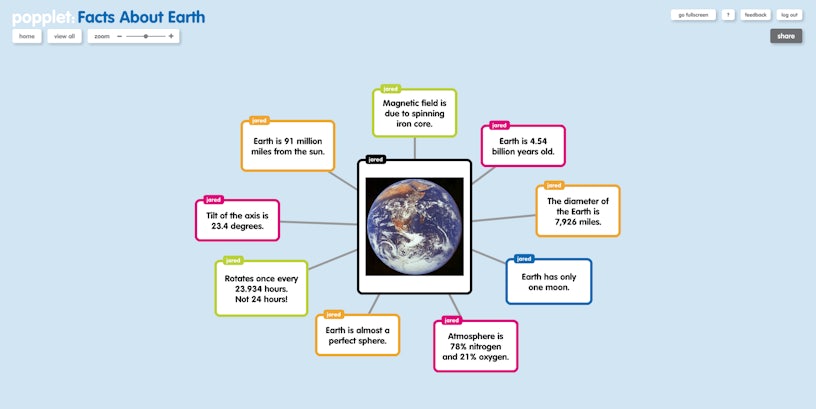Christmas is now a (sadly) distant memory and we’re all back at work trying hard to stick at our New Year’s resolutions, if they’ve not been broken already!
Most of our resolutions tend to relate to things we’d like to achieve in our personal lives, such as losing weight or taking up a new hobby, but what about things we’d like to accomplish at work?
Inspired by other ‘top tool’ round-ups I’ve seen and enjoyed, I thought I’d share one of my own. To find something new to try this year, finish the sentence below:
My New Year’s resolution is to…
Keep on top of the news
Basic – free
Pro – $5.41 per month, billed annually
I’ve been using Feedly for a while now to keep up-to-date with digital marketing trends and client industry news. It’s a fantastic time-saving tool because it collates so many different sources into one single place, and works in conjunction with another of my favourite tools, Instapaper, which I’ll talk about later.
Its easy-to-use, personalisable interface allows you to take in headlines at a glance to determine what’s important (and what’s not) and you can choose to view ‘all’ news or news by ‘collection’. I find the only restriction is that it’s powered by RSS, which some of my favourite sites don’t have, but its database is still big enough, and flexible enough, that you can find some real hidden gems when you search by keyword, or hashtag. It also suggests other sites/blogs you might like to follow.
Other features include the ability to save articles for later, to mark articles as ‘read’ and to share on social media – or with your teammates.

Basic – free
Various subscription packages for those looking for advanced API features
Anders Pink is relatively new to the market, having been founded in 2015 by the co-founders of BuzzSumo and e-learning company Kineo. Its premise is very similar to Feedly, but it has a better functionality when it comes to sharing articles with your team.
Along with personalised (private) ‘briefings’ you can create briefings to share with your colleagues, giving the whole tool a real interactive feel to it. I especially like the fact that you can see your team’s recent activity through the ‘team dashboard’ – whether they’ve ‘upvoted’ a piece a content they particularly liked, pinned it to a board (so everyone can read it later), or flagged it as a ‘must read’. You can even add comments on articles, using a person’s @ handle to address them directly.
What also makes this tool unique is the fact that you can create briefings based on your favourite influencers on Twitter – this is something that’s only available on the Pro Plan, which is currently free while the tool is in Beta.
I spoke to co-founder Stephen Walsh about the idea behind Anders Pink. He said: “We built Anders Pink because we needed it ourselves. We all start every day with the best intentions to stay smart and learn more about our professional interests and passions, but it’s hard work to stay on top of new content. You can subscribe to RSS feeds, or check Twitter but you can get overloaded with irrelevant content. With Anders Pink, we wanted to make it easy to take control of content curation. You have complete control over your sources – specific domains, Twitter influencers, RSS feeds and keyword filters.
“We’re adding more to the platform all the time. In our next release we’ll anticipate the topics and sources that you’ll find the most useful, which will make it even easier and faster to find and filter the most relevant content for you.”

Become a whiz at research and writing
Free
It sounds cliché but I really would describe this tool as revolutionary. It takes a while to get to grips with at first but once you understand the concept and the science behind it it will change the way you carry out your research. In basic terms it’s a bit like skim reading, but with Spritz you get to read every word, but faster! Here’s how it works: Once you’ve installed the tool, head over to a page that you want to read, open the bookmarklet, press play and take in the words by focusing on the red character. How does it help? It’s all in the science, as the Spritz website explains: “Removing the eye movements associated with traditional reading methods not only reduces the number of times your eyes move when reading, but also decreases the number of times your eyes must pass over a word for your brain to understand it. This makes spritzing extremely efficient, precise, convenient and comfortable.” What’s more, you don’t need any training in order to use the tool, and once you feel content with the speed you’re at you can increase it up to 700 wpm!
Free
Here’s one for those who need more motivation to write, especially on a Friday afternoon! Written Kitten is a fun little tool that enables you to see a cute picture of a cat/puppy/bunny for every 100, 200, 500 or 1,000 words you write (your choice).
For proofreading, I like to use Hemingway App – a free tool which helps improve the readability of your copy by a making a number of suggestions. Suggestions include making your sentence easier to understand, shortening words and sentences and removing adverbs and weakening phrases. It also tells you how many characters/words your copy is, and a reading time (approximate).

Better track the results of my campaigns
Basic – free
Pro – from $4 a month
I generally use Buzzstream to create personalised emails to send to journalists when outreaching. While the tool allows me to track which emails have been opened/clicked on, and when, I prefer the real-time notifications that I get with with Mail Track. It can be incorporated into your Gmail account, and will present you with a pop-up box every time one of your emails has been read. You also get an email with more granular details including how long it took your recipient to read your message after it was sent, how many times it was read, and on what device. For easy viewing you can click on your ‘sent mail’ to see which of your emails have been read, indicated by two green ticks. One of the ways I like to use this tool is to get a feel for how well my campaigns are going. If a journalist has opened my email a couple of times but has not replied to me, then they’re probably not interested. Equally, if they haven’t opened my emails in a couple of weeks I may have contacted the wrong person to begin with.
From $29 a month after the free trial
I use a variety of methods to monitor campaign coverage, but one tool that I keep coming back to is Mention. It’s so easy to use – you simply set up an alert choosing required, optional and excluded keywords, and then watch in real-time as your brand (or client’s brand) is cited. Mention picks up coverage on publications and blogs, as well as social media, and I find it to be a lot more receptive than using Google Alerts or Google News alone. Patrick Whatman, head of content at Mention, told me: “Mention has a simple goal: to help businesses discover who’s talking about them online, and what they’re saying. We crawl the web, forums, and social media, to make sure that you never miss a mention.
“Why businesses need this information can vary. Customers use Mention to build brand awareness, protect their reputation, and find new clients. Others want to monitor their competitors, and we also help people find influencers to talk about their products.
“In 2017 we’re working hard to add to our analytics tools, because we know this is important for our customers. That means more data visualization options and customizable dashboards. We’re expanding our Facebook and LinkedIn monitoring to provide even better coverage.”
Be more organised
Free
As mentioned earlier, Instapaper is one of my favourite tools to use on a day-to-day basis. Want to read that article but too busy right now? Save it on Instapaper. Want to highlight articles and make notes on them without printing them out? Do it on Instapaper. I use it at work in conjunction with the Chrome extension (which lets you save a page with the click of a button) and then catch up on on the app – generally on my way to or from work! Similar to other tools, Instapaper also allows you to separate saved articles into different folders, and archive, ‘like’ and share them via email.

Basic – free
Also offers a paid-for subscription for $3 a month / $30 a year
If you’re a visual thinking/learner, and are guilty of organising everything through a series of colours like me, then Popplet is the one for you. Essentially, it’s like a blank sheet of paper where you can brainstorm all of the random ideas you have throughout the day, but don’t want to forget! You can either create your own or use one of the example ‘popplets’ or public ‘popplets’ as inspiration.

Basic – free
Various subscription packages from $2 a month
It takes a while to use properly, but Follow Up Then is a real aid to productivity, helping you achieve a ‘zero inbox’ (or as close to it as possible!) Basically, the tool enables you to become “your own personal assistant” by reminding you to do something at a certain time. Say, for example, you have an email that you need to reply to – by forwarding it to tomorrow12pm@followupthem.com you’ll receive that email back tomorrow at 12pm, and so on. There are so many email combinations to try which perform different functions, or you can customise them yourself.
The tools we love
At Impression we love a good tool, and we’re always on the lookout for ‘the next best thing’. Here are some of my colleagues’ favourites:
 “With our outreach campaigns, we want to be gaining as high a response rate as possible. This means that our outreach emails have to be both assertive and eye catching to grab the recipient’s attention. This is where the “Just not sorry” Chrome plugin becomes a great helping hand.
“With our outreach campaigns, we want to be gaining as high a response rate as possible. This means that our outreach emails have to be both assertive and eye catching to grab the recipient’s attention. This is where the “Just not sorry” Chrome plugin becomes a great helping hand.
“The plugin flags up potential words which may diminish the tone of your emails. This is great, because it allows our outreach efforts to be more concise and authoritative, which is vital when contacting a recipient with a potentially saturated inbox.” – Pierre Melion, digital marketing assistant
 “When you’re part of a team of ‘outreachers’, it’s important that you can keep up to date with your team’s activity, their new contacts and even their ‘notes to self’: Buzzstream allows me to do all of this and more. It’s a contact book and a memo pad in one.
“When you’re part of a team of ‘outreachers’, it’s important that you can keep up to date with your team’s activity, their new contacts and even their ‘notes to self’: Buzzstream allows me to do all of this and more. It’s a contact book and a memo pad in one.
“I’ll start any outreach activity by creating a researched, targeted list of contacts and then work my way through this list. It’s easy for me to see if a colleague has an established relationship with a journalist, or if they have covered our clients before, and I will usually reference this in my email – there’s no better ice breaker! Once my outreach is completed, Buzzstream allows me to track what percentage of my target list has opened by email. Comparing these percentages for different outreach projects enables me to evaluate the effectiveness of email length, subject line and tone.” – Lauren Wilson, digital PR executive

“Gorkana is really useful for finding the right contact at a publication, which greatly improve the response rate amongst recipients and helps you personalise your outreach. In terms of data and inspiration, I use the ONS website quite a lot to see what information is available in the public domain, and What Do They Know when that data isn’t readily available.” – Laura Hampton, digital marketing manager
The tools you love
And here are some of the tools that you love:
“I use ResponseSource journalist enquiry service. The reason I find it so useful is as an engineering company the type of media that we can utilise is quite small, a lot of what we do is specialist. If I can’t go back to a specific enquiry I can still use the publication and the contact as a potential source of coverage, discussing with them content they would like from us. It is also a quick way to see what people are talking about in your industry without having to scroll through pages of news. It picks up trends really quick as journalists will ask for comments and information.
“I also use the Journorequest and PRrequest hashtags on Twitter, again this is great to see what people within your industries are talking about and what journalists want more of. We can then tailor our content around what we know professionals in our industry want to read.
“However, no tools will ever provide what can be gained from research. It takes a long time and can be painful, but finding an article written by a journalist who has covered an aspect of your business or your messages and contacting them directly, is always the best method. I get far more responses contacting relevant journalists directly and striking a personal cord by talking about their work.” – Rhian Williams, public and media relations at Majenta Solutions
“My chosen tool is Ahrefs. A multi-use tool; with Ahrefs you can analyse trending content, the volume of organic traffic it attracts and the number of shares across Twitter, Facebook, Google+, LinkedIn and Pinterest. You can also see the specific accounts that have shared it on Twitter.
“As well as trending content in your industry, you can see which sites your competitors are featuring on and the content that they are contributing; whether that is guest posts, creative content such as infographics or quizzes, images or expert comments – you have access to it.” – Amy Bull, content executive at Datify
“Answer The Public is a free tool that allows you to enter keywords and find content ideas based on what people are searching for. You can quickly collate a list of potential ideas and then use another free tool called Google Adwords Keyword Planner to find how many people search for terms related to your article ideas on Google. It’s an excellent method to ensuring that there is demand for the articles that you’re going to write.” – Mary Brandom, SEO and PPC manager at WED2B
“Buzzsumo is great for marketing campaigns as it does so much. We use it from the start of a campaign right through to the end and beyond, making it an invaluable tool in our campaigns. You can use it to find the most shared content, find journalists and influencers who have written about similar topics, find sites that might be of interest and, once you’ve done all that, you can set up alerts so you know when it’s being talked about. What more could you want? – Jonathan Russell, CMO at Bizdaq
“The key to writing a successful piece, whatever it may be, is relevance. As a writer I like to search the web and see what’s going on in the world right now and see whether or not us as a company can get involved. We tend to use Trello often and have a national days board so we know what key dates are coming up in the future that we could write about. We will then do a keyword analysis using WEBceo.com or Google Adwords to find the perfect keyword to get a higher ranking. Having this information stored away means quicker research and more effective writing, as we know our audience wants to read it.” – Shannon Valentine, communications executive at The Typeface Group
Have we missed any? Tell us your favourite tool by leaving us a comment below.
* Disclaimer – none of the tools mentioned in this blog have paid for their inclusion


